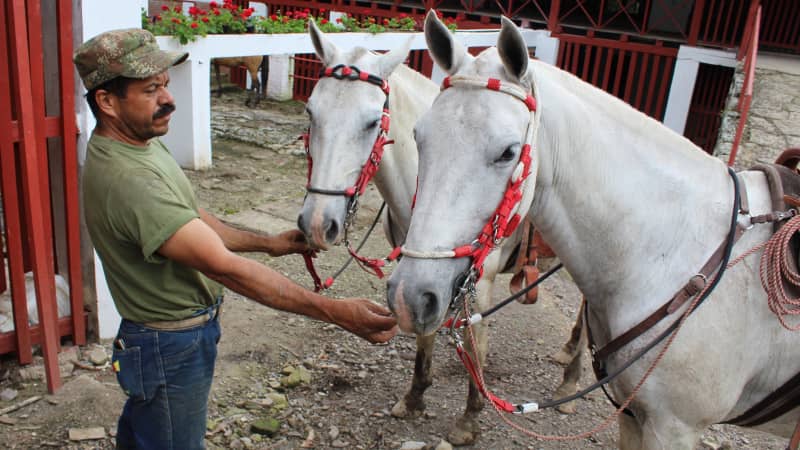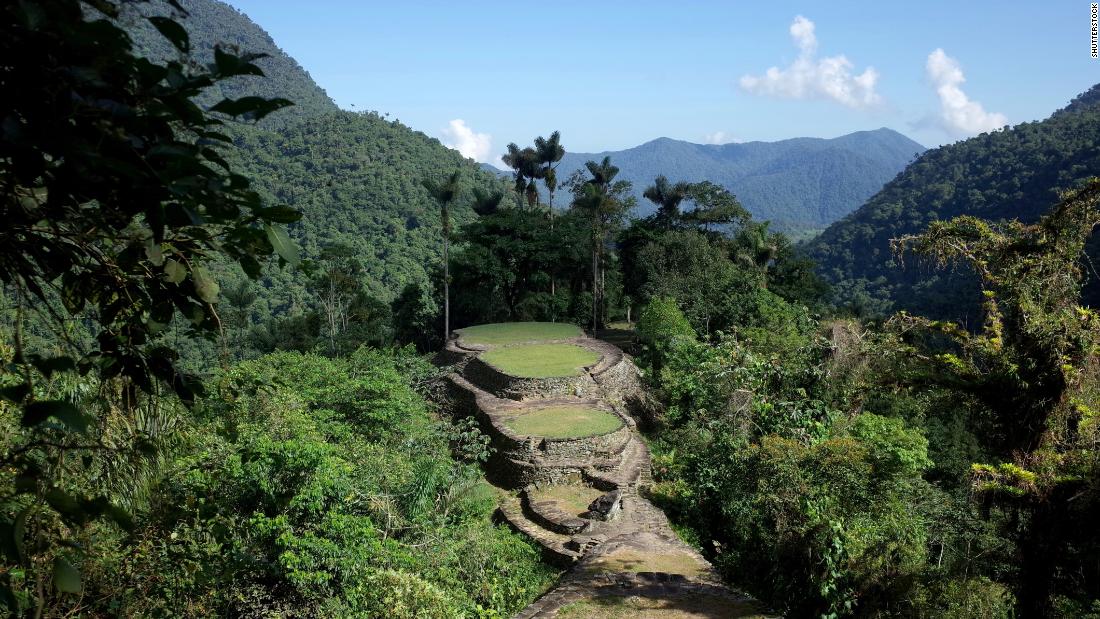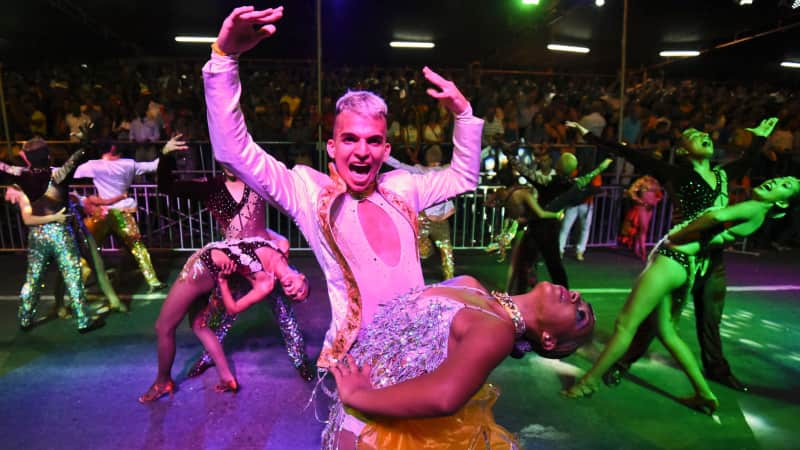There are still plenty of less explored natural treasures to discover, from swimming among mangroves by starlight to spotting rare birds in the remote mountains. Colombians also know how to indulge, and a trip during normal times wouldn’t be complete without heading to the best food, drink and dancing spots.
Be sure to gauge local Covid case levels before traveling and steer clear of demonstrations, which have resulted in violence recently in some major cities.
When you are comfortable traveling to Colombia, here are 13 of the best things to do:
Coffee plantations
Colombia is famed for its coffee. Although in past years the country — which is the world’s third largest producer of coffee — used to export all the good stuff, recently Colombians have started keeping the best for themselves.
There’s no better way to trace the legacy of Colombian coffee than by visiting a plantation. Travelers can hitch a ride in a traditional “Willy” car, an American car used in World War II that’s now beloved by Colombians to cart things around.
Don’t forget to buy a bag to take home.
Horse riding at Cafetal de la Trinidad

Riding is part of the allure at Cafetal de la Trinidad, a former coffee plantation.
Courtesy Cafetal de la Trinidad
Yet in recent years, the family’s youngest son Alejandro and his partner Anna have lovingly restored the finca — or farm — to its full glory and are now opening it to visitors.
Just two hours out of Bogotá but worlds apart, visitors can make the most of the remote location, fresh air and breathtaking scenery by saddling up on one of the farm’s horses and trekking across the stunning countryside.
Guests can even take a picnic and toast the beautiful sunset over the mountains as their horses patiently graze in the fields.
Swimming with bioluminescent plankton
If the crystal clear ocean wasn’t beautiful enough already, visitors to Isla Múcura can take a nighttime dip among the coastal mangroves and watch as the pitch black water lights up with millions of blue-green plankton.
The tiny organisms produce light using a chemical called luciferin, and glow when they are moved. So it’s possible to kick back and watch the stars while floating on the Caribbean Sea, or you can dip your head below the water and feel as if you’re a character in “Avatar.”
Bandeja Paisa in Medellín
There is no meal more Colombian than the Bandeja Paisa: hearty, meaty and eye-poppingly huge.
And there is no better place to eat Bandeja Paisa than in Medellín, the capital of Antioquia and home of the paisa — the name for inhabitants of the Antioquia, Risaralda and Quindío regions.
The dish is usually served on an oval platter and consists of red beans cooked with pork, rice, carne molida — ground meat — chicharrón, fried egg, plantain, chorizo, arepa, hogao — a thick tomato salsa — black pudding and avocado.
Scuba diving in Cartagena
Although Cartagena is best known for its old, walled city, winding cobbled streets and colorful balconies, the city also has a wealth of underwater treasures.
Boasting the Rosario Islands, a natural reserve comprised of 43 tropical islands, an underwater museum, coral reefs and shipwrecks, this stretch of the Caribbean Sea has plenty to discover.
Birdwatching in Serranía del Perijá
Colombia is home to more than 1,900 bird species — the highest number in the world.
The Perijá mountain range, which straddles the border of Venezuela and Colombia, is one of the best places to go birdwatching and is home to several endangered species that cannot be found anywhere else.
Salsa dancing in Cali
Cali is the capital of salsa, where dancers take to the floor as early as the afternoon.
Although the dance has its origins among the Cuban population in New York City in the mid 1900s, it wasn’t long before salsa reached Colombia. Cali decided to produce its own style of salsa, and the city has never looked back.
There are two types of dancers: the old school purists, who stick to the original footwork, and the younger crowd, who like to dance with flair and gymnastic-style lifts.
Whale watching
Every year between June and October, locals along the Colombian Pacific coast of Nuquí ready themselves to watch humpback whales migrate past their shores.
Located in the Gulf of Tribugá in the Chocó department, Nuquí is the perfect place to catch a glimpse of the mothers and their newborn calves, thanks to its warm waters, free of strong current, and little passing boat traffic.
Hunting for a glimpse of ‘pink’ dolphins
Pink dolphins are often thought of as the stuff of myths, and although they’re still a scientific enigma, they can be found in the Amazon River.
An amazing restaurant
The 2.76 square mile restaurant boasts five kitchens, 11 dining areas, two dance floors and normally packs in thousands of people a night. Be sure to check on Covid safety measures before booking during the pandemic.
Although it’s a 45-minute drive outside of the capital, it is the place to go in Bogotá and has fed the likes of the president, Shakira and the Red Hot Chili Peppers with its 64-page menu.
But the food, featuring traditional Colombian dishes such as chicharrón and patacón to steak and empanadas is just the half of it. After dinner, everyone takes to the dance floor, clutching aguardiente — a traditional Colombian anise liquor — and salsas the night away.
Lost City trekking
The Lost City is Colombia’s answer to Machu Picchu — just cheaper with fewer tourists.
Stargazing in Tatacoa
Tatacoa may look like a desert, but it’s in fact an ancient dry tropical forest. The environmental wonder sees astronomers from all over the world flock to the red Mars-esque landscapes to stargaze.
Thanks to its unique position, constellations of both the northern and southern hemispheres can be viewed, making for an awe-inspiring experience.
Crab-swerving in Providencia
For a few weeks every year, Providencia, an island closer to Nicaragua than Colombia, is occupied by the Colombian army, who fly in to protect the thousands of black crabs migrating to the sea.
Roads are closed and locals adopt a practice known as “crab-swerving” to avoid hitting the crustaceans, who are protected by local laws and environmental policies.
The crabs are a local delicacy, and provide many islanders with their sole income. Due to rising tourism in neighboring San Andres, crab numbers have declined, and so the army was brought in to ensure the migrating crabs had a safe passage down to the sea to lay their eggs.
And if you miss migration season — when fishing, consuming and selling the crabs is banned — you’ll get a chance to taste one and see what all the fuss is about.


